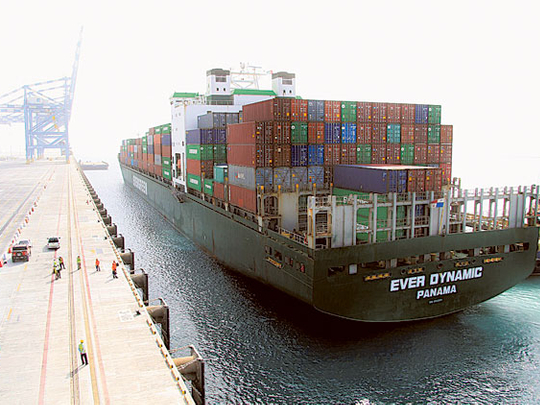
Abu Dhabi: The new Khalifa Port located in Taweeleh will officially be opened on Saturday, with phase one in full operation. Situated by the Khalifa Industrial Zone Abu Dhabi, or Kizad, the multi-billion dollar project will change global trade with the UAE as its capacity will be six times that of Mina Zayed.
In its first phase alone, the port will have the capacity to handle 2.5 million TEUs (Twenty foot Equivalent Units) annually. This could go up to 5 million, plus 15 million tonnes of general cargo. Once the second and third phases come online, the port is expected to have a capacity of up to 15 million containers a year.
However, Abu Dhabi Terminals doesn’t expect the port to reach its full capacity in its early stages. The container business will remain in Mina Zayed.
The first phase is expected to operate at full capacity within the first five years.
Khalifa Port will be able to handle vessels that are longer than 400 metres and ships with drafts that are up 16 metres long. The port also will also be the first semi-automated terminal in the region to control container movement.
Economic vision
“We are committed to working closely with other key public and private sector entities towards Abu Dhabi’s 2030 Economic Vision which aims at promoting a more sustainable, diversified and knowledge-based economy,” Martijn Van de Linde, Chief Executive Officer of Abu Dhabi Terminals told Gulf News yesterday.
“Khalifa Port is one of the world’s most technologically advanced ports featuring the latest technology and designed to accommodate the world’s largest Post-Panamax ships,” said Dr Sultan Ahmad Al Jaber, Chairman of Abu Dhabi Ports Company (ADPC).
“The cost up to the fourth quarter of 2012 is estimated to be Dh26.5 billion for Khalifa Port phase one and Kizad zone A,” he said.
While the port has been primarily designed to accommodate Mina Zayed’s traffic, in reality it will push Abu Dhabi’s growth in the trade industry.
“The UAE has been highly dependent on oil revenues over the course of the past few decades and the government recognises the persistent need to diversify the economy,” Al Jaber said. “Trade is a major pillar by which diversification can be achieved and ADPC promotes trade through its ports. In addition, the port serves as a dedicated enabler for the adjacent Khalifa Industrial Zone Abu Dhabi (Kizad), also developed by ADPC, and which will be one of the largest industrial zones in the world.”
Effective standards
“The port will play a pivotal role in enabling trade with regional and international markets, so we are ensuring that the highest and most effective standards and procedures are implemented in all operations of the port,” de Linde said.
Once it is in operation, vessels will be able to sail directly to the UAE, which would lower the cost of transport, he said. This will drive down the cost of trade which will positively affect the economy of Abu Dhabi, making it more competitive.
Phase two of the project will consist of the development of another terminal handling the same capacity once the demand is needed.
“Under the current plant, there will be five phases of growth of the Khalifa Port,” Al Jaber said.
As for Mina Zayed, it will continue to grow its cruise liner business in Abu Dhabi in addition to existing general cargo.











